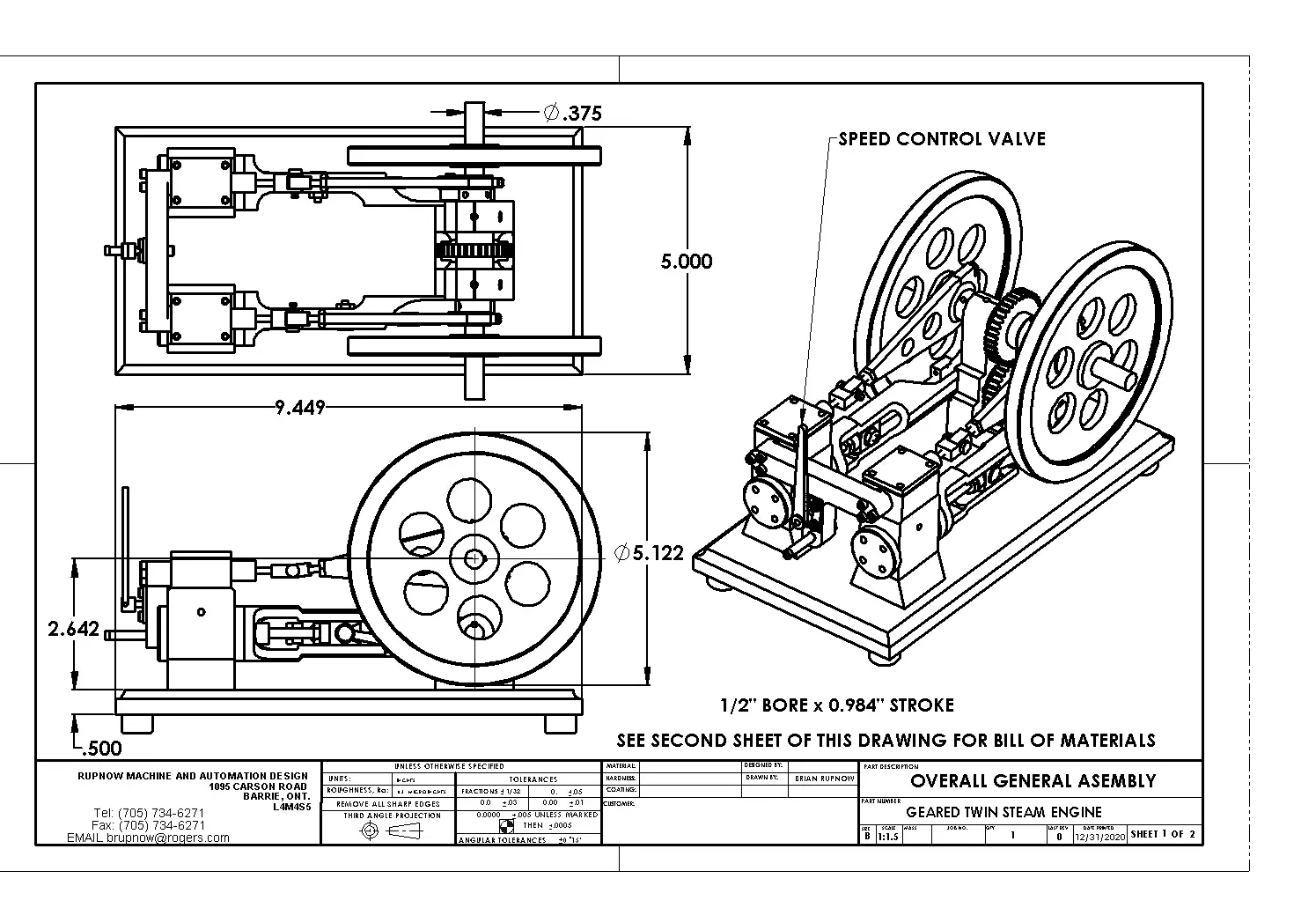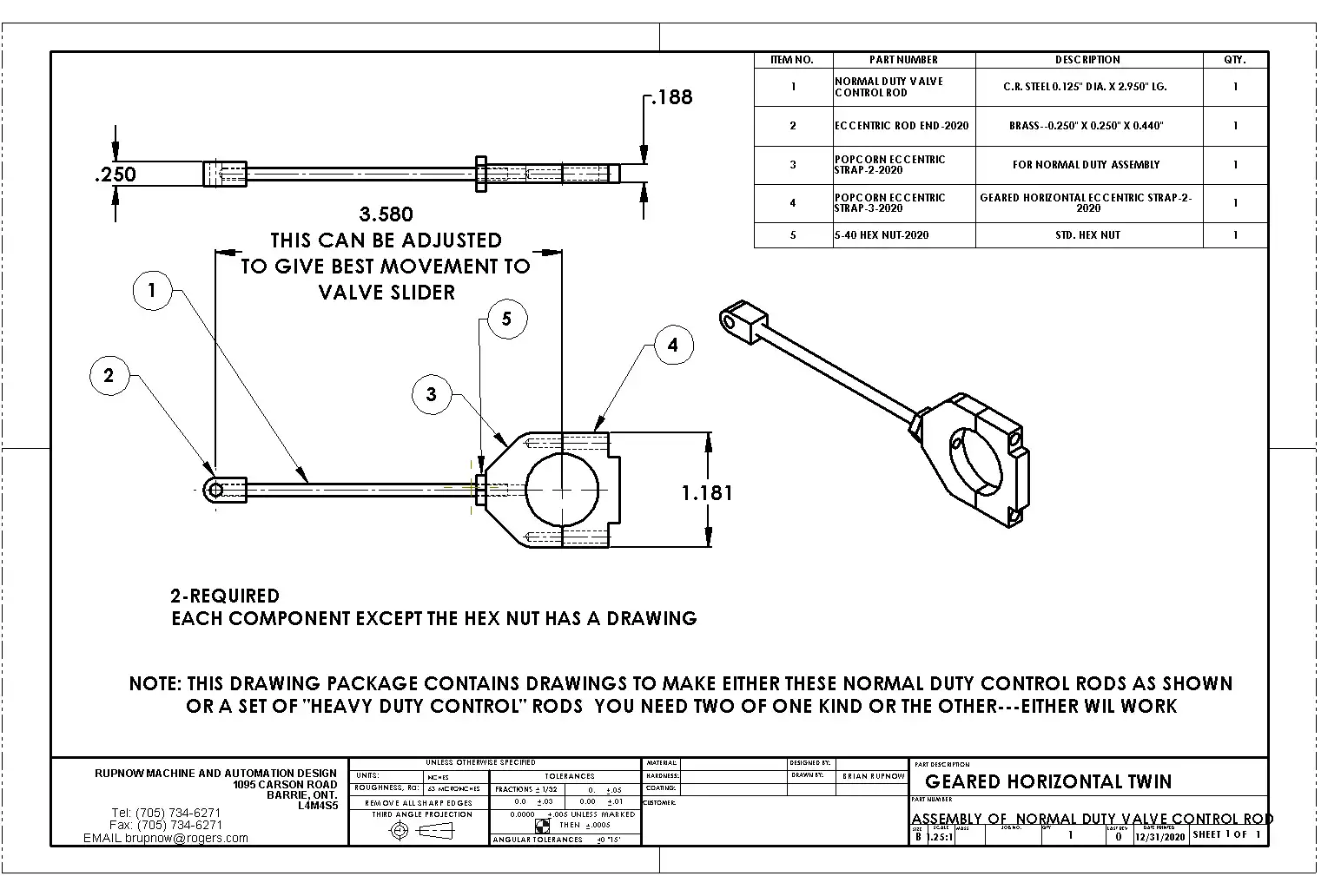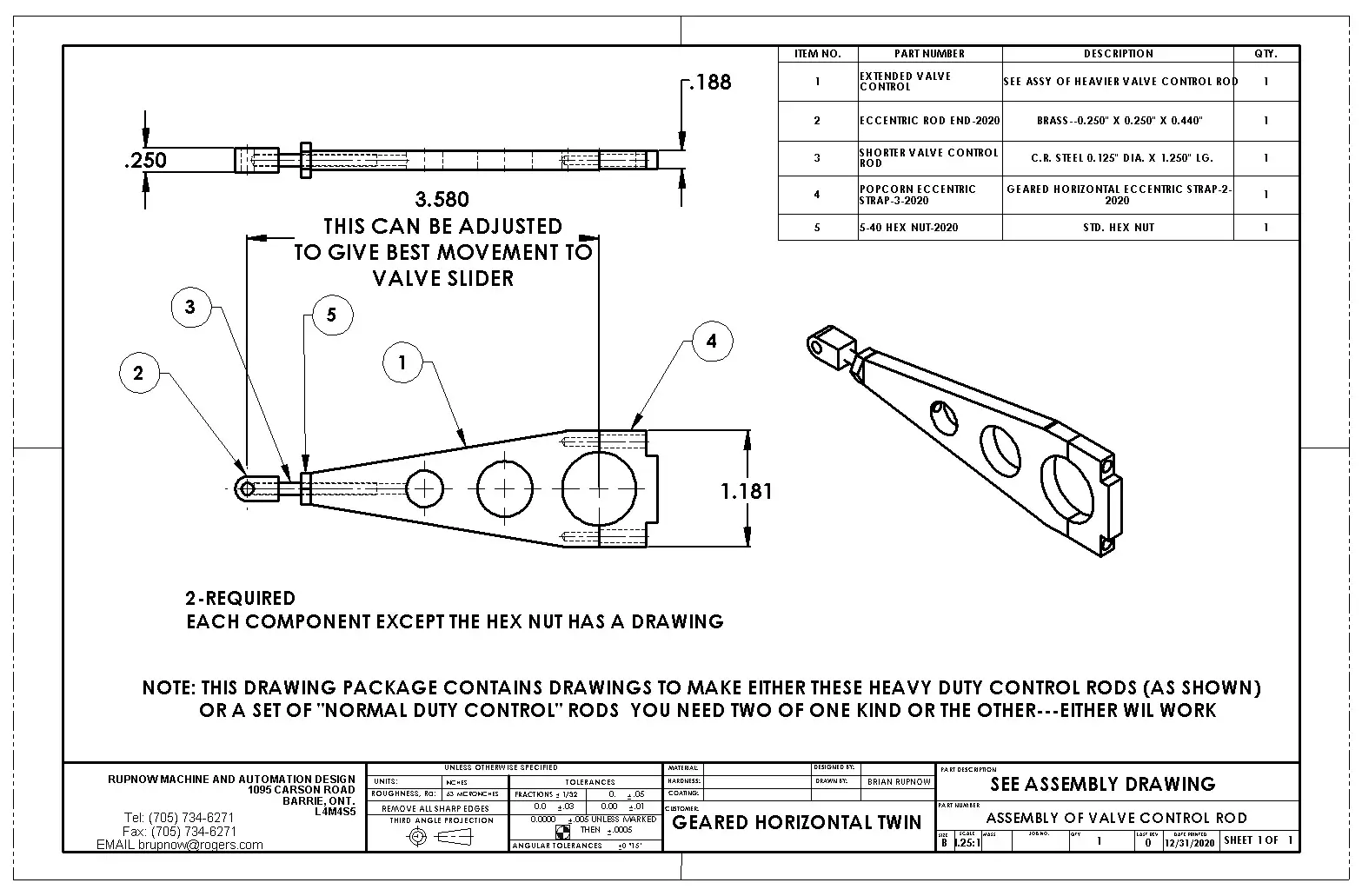So here we have it kiddies. After a sometimes frantic 5 weeks from concept to completion, we have a running twin cylinder engine with the flywheels running off the camshaft. I still have timing events to adjust, and some painting to do, but this "maiden run" has been successful. I will sell a complete plan set for this engine for $25 Canadian funds, and I will find a commercial source for the gears if you don't have your own gear cutters.---Brian
You are using an out of date browser. It may not display this or other websites correctly.
You should upgrade or use an alternative browser.
You should upgrade or use an alternative browser.
Geared horizontal twin engine
- Thread starter Brian Rupnow
- Start date

Help Support Home Model Engine Machinist Forum:
This site may earn a commission from merchant affiliate
links, including eBay, Amazon, and others.
- Joined
- Sep 2, 2011
- Messages
- 1,396
- Reaction score
- 387
That is nice Brian, question on a cross head valve is the brass head inside the steam chest so close that it presses on the top and the bottom or what keeps the seal going on? i mean i do understand covering one hole and un covering the other but what about leakage? - never made anything other than a wobbler on the steam side so curious about the cross head valve. love all the ecentrics and actuation.
Steam (or air) pressure inside the steam-chest forces the sliding valve down against the slots in the top of the cylinder. The higher the pressure is, the harder it pushes. Some people lap the two faces that slide against each other for a more perfect seal. The nut which sets inside the towers on top of the slide valve actually "floats"---It doesn't supply pressure anywhere except back and forth as the rod moves it. Nothing forces the sliding valve down against the cylinder ports other than steam (or air).
- Joined
- Sep 2, 2011
- Messages
- 1,396
- Reaction score
- 387
ah so lets say the steam comes in from the top, and both intake and exhaust are on the bottom then. thus constant preasure is applied to the top. and some lubrication as well - which is im gussing why alot say to add steam lube to the boiler?
The slightly larger center port is exhaust. The smaller port to either side go to either the rod end or the cap end of the cylinder. The slide valve has a cavity machined in the bottom of it, so depending on where the eccentric is at, it either connects one end or the other to the exhaust port. The slide valve is only long enough to cover two ports at once, so the third slot which is uncovered lets pressurized steam/air into the other end of the cylinder.
- Joined
- Sep 2, 2011
- Messages
- 1,396
- Reaction score
- 387
makes much better sense now. thanks.

$99.99
AHS Outdoor Wood Boiler Yearly Maintenance Kit with Water Treatment - ProTech 300 & Test Kit
Alternative Heating & Supplies

$39.99
$49.99
Sunnytech Low Temperature Stirling Engine Motor Steam Heat Education Model Toy Kit For mechanical skills (LT001)
stirlingtechonline

$24.99
$27.99
HOZLY 5PCS/Lot ISO30 Tool Holder Clamp Flame Proof Rubber Claw CNC Machines Automatic Tool Changer
HOZLY
![DreamPlan Home Design and Landscaping Software Free for Windows [PC Download]](https://m.media-amazon.com/images/I/51kvZH2dVLL._SL500_.jpg)
$0.00
DreamPlan Home Design and Landscaping Software Free for Windows [PC Download]
Amazon.com Services LLC

$45.99
Sunnytech Mini Hot Air Stirling Engine Motor Model Educational Toy Kits Electricity HA001
stirlingtechonline

$20.28
$24.95
Backyard Building: Treehouses, Sheds, Arbors, Gates, and Other Garden Projects (Countryman Know How)
Amazon.com

$94.99
$109.99
AHS Woodmaster 4400 Maintenance Kit for Outdoor Wood Boiler Treatment
Alternative Heating & Supplies

$38.70
$49.99
Becker CAD 12 3D - professional CAD software for 2D + 3D design and modelling - for 3 PCs - 100% compatible with AutoCAD
momox Shop

$649.00
$699.00
FoxAlien Masuter Pro CNC Router Machine, Upgraded 3-Axis Engraving All-Metal Milling Machine for Wood Acrylic MDF Nylon Carving Cutting
FoxAlien Official

$24.99
$34.99
Bowl Sander Tool Kit w/Dual Bearing Head & Hardwood Handle | 42PC Wood Sander Set | 2" Hook & Loop Sanding Disc Sandpaper Assortment | 1/4" Mandrel Bowl Sander for Woodturning | Wood Lathe Tools
Peachtree Woodworking Supply Inc

$89.99
Outdoor Wood Boiler Water Treatment Rust Inhibitor- AmTech 300 & Test Kit
Alternative Heating & Supplies

$18.90
$22.90
Woodturning Double Ended Bowl Calipers Stainless Steel 11Inch Woodworking Caliper Tools
sdltools
An interesting engine , Congratulations !
Thanks for sharing.
Thanks for sharing.
- Joined
- Oct 1, 2010
- Messages
- 1,407
- Reaction score
- 434
That's great, Brian.
I've been following along and I really appreciate all of your progress reports. I'm looking forward to the video that shows it tuned and painted.
--ShopShoe
I've been following along and I really appreciate all of your progress reports. I'm looking forward to the video that shows it tuned and painted.
--ShopShoe
This is the final "wrap up" of my geared horizontal engine. Painting and polishing has been completed, and there really is nothing further to do on this project. It has kept me entertained for a month, and shows that yes, the flywheels can be mounted on a geared shaft which is driven by a gear mounted on the crankshaft. I have seen this discussed many times, but the answers were always a bit ambiguous. This answers the question. Thank you for following my build thread.---Brian
Tim Wescott
Well-Known Member
- Joined
- Jun 3, 2018
- Messages
- 328
- Reaction score
- 99
... and shows that yes, the flywheels can be mounted on a geared shaft which is driven by a gear mounted on the crankshaft. I have seen this discussed many times, but the answers were always a bit ambiguous. This answers the question. ...
Well, the jury won't really be in until you run it for a year straight, then tear it down and inspect for wear.
Well done Brian. Personally, I would have removed most of the material from within the eccentric straps as they simply look far too heavy to my eye. (Maybe you are a bit unsure yourself, from the tone of your posts? A web should be mostly space holding outer the outer (thick) rails apart, like any well designed "minimalist" beam. Possibly I would have made them using brass extrusions as 2 outer rails forming the triangle with the eccentric bearing, with just a couple of stiffening struts (for appearance) filling the triangular gap. Otherwise a nice looking job!
How is the balance? I wonder if you put the primary counterbalance (in opposition to the big-end, pistons, cross-heads and rods) on the crank, then applied some secondary counterbalance (for the side-to-side oscillations of the con-rods plus counterbalance for the eccentrics?) on the crankshaft? That way there would be little torsional oscillation in the gears. Could the counterbalancing even be achieved by the calculated drilling of gears, so un-drilled zones become the counterweights? Lots of scope with your design and I am curious as to what you have done.
I'm sure as a Design Engineer you can do the calcs, (I would love to see them to learn from you!) but I just follow the calcs in locomotive design text books. Freezing outside today (and cold in the garage) so I may just have a play with the text books and slide rule myself on some guesstimated masses of your design!
Brian's fun becomes Brain fun!
Goodonya! - and Happy New Year. I look forward to more of your genius in 2021.
K2
How is the balance? I wonder if you put the primary counterbalance (in opposition to the big-end, pistons, cross-heads and rods) on the crank, then applied some secondary counterbalance (for the side-to-side oscillations of the con-rods plus counterbalance for the eccentrics?) on the crankshaft? That way there would be little torsional oscillation in the gears. Could the counterbalancing even be achieved by the calculated drilling of gears, so un-drilled zones become the counterweights? Lots of scope with your design and I am curious as to what you have done.
I'm sure as a Design Engineer you can do the calcs, (I would love to see them to learn from you!) but I just follow the calcs in locomotive design text books. Freezing outside today (and cold in the garage) so I may just have a play with the text books and slide rule myself on some guesstimated masses of your design!
Brian's fun becomes Brain fun!
Goodonya! - and Happy New Year. I look forward to more of your genius in 2021.
K2
Sorry Brian, I trawled through my memory - and referred back to your posy #89 - you told me you don't balance the small models. So please ignore my forgetful stupidity (I.E. I forget how stupid I am!).
Werowance, your post re: valcves and sealing: refer to post #100 where Brian shows the linkage normally hidden inside the valve chest - that allows the valve to be pressed against the cylinder by application of the cross-bar and floating valve arrangement. - Another "Well done Brian!" - It is all there when you take the time to look - and look again!
Thanks Brian.
K2
Werowance, your post re: valcves and sealing: refer to post #100 where Brian shows the linkage normally hidden inside the valve chest - that allows the valve to be pressed against the cylinder by application of the cross-bar and floating valve arrangement. - Another "Well done Brian!" - It is all there when you take the time to look - and look again!
Thanks Brian.
K2
- Joined
- Oct 1, 2010
- Messages
- 1,407
- Reaction score
- 434
Brian,
I seem to always like the level of bling you do: "Finished" looking, but not over the top.
I think the blue color was a good choice for this engine.
I hope to see your next project when you are up for it.
--ShopShoe
I seem to always like the level of bling you do: "Finished" looking, but not over the top.
I think the blue color was a good choice for this engine.
I hope to see your next project when you are up for it.
--ShopShoe
- Joined
- Feb 26, 2020
- Messages
- 700
- Reaction score
- 434
Hello Brian,
I was trying to figure out the reason for the gear arrangement? ( I gave up reading all the posts for the answer ) Why does it make sense? Or is it only for the fun of using gears? Just wondering.
Happy new year.
I was trying to figure out the reason for the gear arrangement? ( I gave up reading all the posts for the answer ) Why does it make sense? Or is it only for the fun of using gears? Just wondering.
Happy new year.
Timo--That was purely a design experiment. I have built so many conventional engines that I wanted to do something different. I have never seen a real steam engine built this way, and I think the major factor was that it was more expensive to put gears on an engine. On a conventional steam engine the crankshaft has the cams riding on it, and there is only the crankshaft to deal with. I would class this as a "novelty" engine.---Brian
Hi Brian,
Glad to see you are including your original design for the valve rods / eccentric straps. As you correctly pointed out the failure of the original items would have been due to incorrect fit. I think the original design is much more elegant, while the heavier version looks seriously over specified. As the well known engineering maxim goes - "If it look right, it usually is. If it looks wrong, it usually is" - this rule does not apply after you have been to the pub....
All the best,
Ian
Glad to see you are including your original design for the valve rods / eccentric straps. As you correctly pointed out the failure of the original items would have been due to incorrect fit. I think the original design is much more elegant, while the heavier version looks seriously over specified. As the well known engineering maxim goes - "If it look right, it usually is. If it looks wrong, it usually is" - this rule does not apply after you have been to the pub....
All the best,
Ian
And, to finish out this thread, what could be better than a video of the engine doing some real work!!!---Brian rupnow
Similar threads
- Replies
- 510
- Views
- 73K
- Replies
- 413
- Views
- 64K
- Replies
- 27
- Views
- 7K
- Replies
- 148
- Views
- 26K


















































